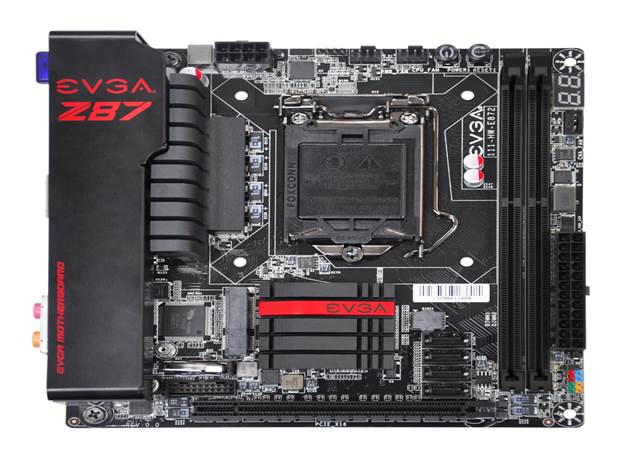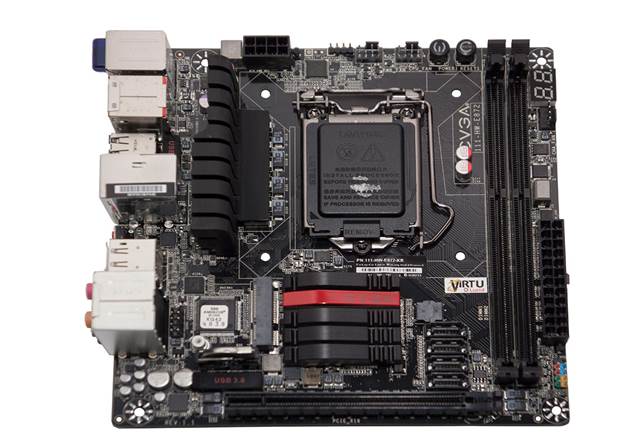EVGA has done very well at making the
Stinger an attractive mini-ITX board, all red and black detailing and I/O
shielding, but if we thought the RoG board was pricing itself out of the test,
EVGA has just gone a step further. Sure, that may sound ridiculous given the
Stinger is only a solitary nugget more expensive than the impressive Impact
board, but this tasty offering from EVGA has nowhere near the extensive armoury
Asus has at its current disposal.
The Stinger may be priced in the same
ballpark as the RoG board, but it is no comparison when you look at the
benchmarks. In terms of straight CPU and memory performance, the Stinger is
still the slowest of all the Intel boards we’ve tested here. Granted, the
difference in real terms is actually kind of slight, but when you’re paying
more for less it simply doesn’t make sense. The performance we were getting out
of the Stinger was much more in line with the $165.41budget ATX boards we’ve
seen over the last six months.

EVGA
has done very well at making the Stinger an attractive mini-ITX board, all red
and black detailing and I/O shielding, but if we thought the RoG board was
pricing itself out of the test, EVGA has just gone a step further.
The difference in the memory results
though is quite pronounced, but again we’re not talking about it actually being
noticeably more sluggish in general usage compared to the other boards. These
synthetic tests do give us an idea where there are some differences in the
performance of the various mobos and, even if such disparity is not immediately
visible when you’re using the machine, they help separate when boards outwardly
seem on the same level.
That’s what EVGA is trying to do with
the Stinger: make it seem like a serious, premium board on the same level as
the RoG Impact. In terms of the visuals it’s got an aggressive looking chipset
cooler and that little cover for the I/O ports to make it feel more like a ‘product’
in its own right rather than just a component of one.

That’s
what EVGA is trying to do with the Stinger: make it seem like a serious,
premium board on the same level as the RoG Impact.
A step behind
However, just as it’s a little lacking
in the synthetic performance, it’s a little behind on the feature set, too.
There’s no Wi-Fi connectivity, though there is a mini PCIe connector if you
were to pick one up separately. We have to admit to not being massive fans of
the Stinger’s BIOS either; it’s relatively flashy-looking, but in practice, we
found it a bit awkward to get things like multiple CPU fans operating
dynamically.
There are a few nice touches though;
the board layout is smart, with enough space to be able to drop a decent low
profile cooler on top of the CPU, and we really like that after the board has
run through its POST codes, the digital readout turns into a live CPU
temperature monitor.
EVGA really is making headway into the
mini PC market at the moment, with the lovely Hadron Air chassis, but its
mini-ITX mobo partner is not quite the motherboard you’re really going to want
to fill it out with – which, if we’re honest, is a bit of shame. The core
problem is simply that the overall package just doesn’t live up to that
painfully premium pricing. If it was knocking around the same sort of price
bracket as the MSI we’d probably be hailing it as a plucky upstart. If that was
the case, the more basic feature set and slightly weaker relative performance
wouldn’t really be an issue.

EVGA
really is making headway into the mini PC market at the moment
|
Vital Statistics
·
Price: $289.4 ·
Manufacturer:
EVGA ·
Chipset: Intel
Z87 ·
Socket: LGA 1150 ·
Memory: Up to
16GB @ 2,666MHz ·
Memory slots
slots: 2x DDR3 DIMM ·
Storage: 4x SATA
6Gbps ·
Ports: 4x USB
3.0, 4x USB 2.0, eSATA, HDMI, DisplayPort
|